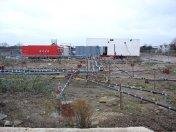Data provider
Budapest University of Technology and Economics, Department of Applied Biotechnology and Food Science, Environmental Microbiology and Biotechnology Group
Contact details
Compulsory sheet of the technology
Financing of the project
Application sphere
- Halogenated aliphatic organic compounds
- trichloroethane
- Halogenated aliphatic organic compounds
- tetrachloroethylene
- Halogenated aliphatic organic compounds
- vinyl chloride
- Halogenated aliphatic organic compounds
- 1,1-dichloroethane
- Benzene and alkyl benzenes (BTEX)
- m-xylene
Description of environmental risk
- Halogenated aliphatic organic compounds
- 1,1,1-trichloroethane
Information on the technology
The technology involves the injection of high pressure steam into an aquifer to thermally enhance conditions so that remediation can be completed at an accelerated rate. Once optimum temperatures have been achieved a high vacuum steam ejector system is used to extract vapours and groundwater. All of the recovered vapour and liquors are cooled in a heat exchange condenser prior to treatment through GAC filters.
The innovative combination of a DPVE system with a system of injecting steam enabled the in-situ treatment of a Xylene impacted clay horizon (located between two permeable horizons) situated above the identified groundwater table. The enhanced system facilitated the delivered steam at high pressure and temperature into the gravel horizon underlying the identified Xylene impacted silt/clay and removed the requirement for excavation.
Technology classification
- thermal
- soil heating with vapour
Technology-monitoring
Costs of the technology
SWOT (evalaution based on scores)
SWOT (evaluation in words)
The physical flushing action of injected steam and hot condensates; Increasing temperatures to change contaminant physical/chemical properties to increase mobility e.g reducing viscosity, capillary/interfacial forces and contaminant density, increasing volatility and desorption rates; Increasing temperatures to affect a change in contaminant partitioning equilibriums, so that a greater proportion of contaminants exist within the dissolved /vapour phases.
Optimising subsurface temperatures for biodegradation.
A vákuum okozta nyomáscsökkenés és csökkenő koncentrációgradiens a talajgáz/gőz talajból kifelé áramlását nagyban meggyorsítja a spontán diffúzióhoz képes. A másik fontos jellemzője, hogy a gőzformájú szennyezőanyag kontroll alá kerül, a kiszívott talajgázzal együtt.
Key risks, in relation to health and safety of personnel, focus on the use of pressurised steam. All staff were appropriately trained and operated to robust, comprehensive, health and safety method statements. Staff expertise was essential to the safe operation of the system.
Mobile steam-production unit and recovery system, highly flexible system, depending of the needs of the site and contaminants.
The effect of heating on soil microflora. The workers risk due to high pressure steam.
